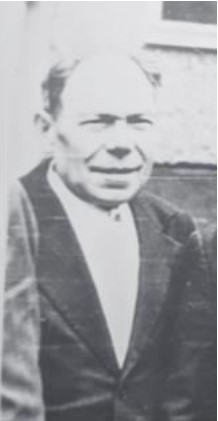Ivan Kalganov
- Place of Birth: Russia
- Date of Deportation: July 1943
- Address when Deported: Unknown
- Place of deportation: Alderney
- Sites deported to: Sylt OT Camp,
By Caroline Sturdy Colls and Kevin Colls
Ivan Kalganov was an inmate of Sylt labour camp who worked for the Neumayer firm. He was born in 1926 in Russia and attended a craft school where he trained to be a fitter. When the Germans arrived in 1941, he fled but in July 1942 – after spending some time working on a collective farm in his village – he was selected for forced labour elsewhere in the Reich by the Germans. In his testimony, he recalled the moment he was deported: ‘I was allowed home to say goodbye to my family, and I remember vividly my three-year-old-brother running after me, waving goodbye’. He was sent with a group of men from the Orel region to Frankfurt am Main and then to Alderney via St Malo.
His first impression of Alderney centred on the ‘barbed wire and signs saying, “Beware of the mines”’. Kalganov was housed in Sylt labour camp from July 1942 until March 1943. Of the camp, he recalled: ‘Sylt was terrible, terrible. If they caught you in the rubbish heap, you would be beaten. Dogs were used against us in Sylt.’ During his time there, Kalganov suffered with boils (for which he received no medical treatment) and he was always wet and exhausted due to the hard labour he was forced to carry out. He was assigned to work at Westbatterie, one of the most notorious places on the island where the mortality rate was high because of the harsh conditions. He never washed during his time in the camp and his lice-ridden clothes were those that he brought with him from home. In addition to the poor rations, the rats and the constant presence of dead bodies in the camp, these conditions led Kalganov to believe that he had little chance of survival.
Only secret food given to him by a German soldier at Westbatterie helped save his life. He witnessed how his fellow inmates were shot, crucified for stealing and beaten in the camp and at work. In March 1943, Kalganov was moved to Helgoland after the arrival of the SS in Sylt. When he finally reached the mainland, he was housed in a French labour camp. He reportedly joined the French resistance in Paris, although it is difficult to evaluate the extent to which he engaged in their activities since many Soviet citizens claimed to have been members of resistance groups in order to demonstrate to the Soviet authorities that they had not collaborated with the Nazis. After a difficult journey to Ukraine, he worked in a coal mine in Donbas before he served two years of a six-year prison sentence issued by the Stalinist regime. Like many former inmates, Kalganov suffered from flashbacks and nightmares about his time on Alderney.
Sources
Ivan Kalganov in Bunting, M. 1996 The Model Occupation, Harper Collins, p.168
N. Tumarkin, The Living and the Dead: The Rise and Fall of the Cult of World War II in Russia (New York: Basic Books, 1994), pp.76.
Map
- Cemetery / Mass Grave
- Concentration Camp
- Forced Labour Camp
- Prison
- Worksite / Fortification
